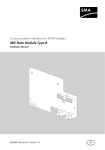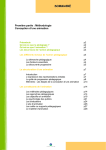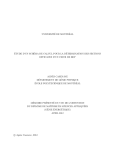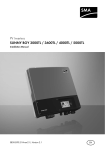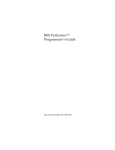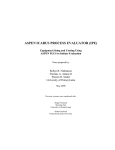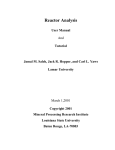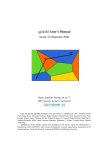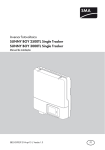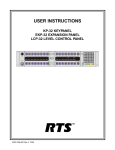Download LIBPF™ User Manual
Transcript
LIBPF_USR_manual_en.odt
2015/04/21
This document is part of LIBPF™
Paolo Greppi – libpf.com © Copyright 2008 – 2015
Credits: Elena Ferrari 2010 – 2011
All rights reserved; do not distribute without permission.
LIBPF™
User Manual
1 of 43
LIBPF_USR_manual_en.odt
2015/04/21
Summary
Introduction............................................................................................................................3
Starting the LIBPF™ user interface ......................................................................................4
Case management.................................................................................................................7
Creating a new case...........................................................................................................8
Saving a case with a new name / description....................................................................9
Retrieving an existing case...............................................................................................11
Troubleshooting................................................................................................................12
Organization of objects and sub-objects..............................................................................13
Simulation............................................................................................................................17
Editing input data..............................................................................................................17
Calculation........................................................................................................................18
Homotopy.........................................................................................................................20
Examining the results...........................................................................................................21
Calculation status.............................................................................................................21
Results..............................................................................................................................24
Units of measurement (UOM)..........................................................................................25
Exporting material and energy balances to LibreOffice / OpenOffice..............................29
Exporting material and energy balances to Microsoft Excel............................................31
Exporting all data to a text file..........................................................................................33
Exporting all data as XHTML............................................................................................34
Sensitivity analysis...............................................................................................................35
Saving and loading sensitivity analyses ..........................................................................40
Settings................................................................................................................................41
2 of 43
LIBPF_USR_manual_en.odt
2015/04/21
This document is the user's manual for LIBPF™ models version 1.0; it addresses users
who want to interact via graphical interfaces with models developed by others (model
user).
Prerequisites:
•
Basic knowledge of the operating system and a spreadsheet (Microsoft Excel,
OpenOffice / LibreOffice Calc);
•
Installed, activated and running LIBPF™ application.
For more information see:
•
LIBPF_USR_installation for the install and removal procedures;
•
LIBPF_USR_activation for the rationale and the functioning of the activation
system.
Introduction
The LIBPF™ (C++ LIBrary for Process Flowsheeting) technology allows you to create an
executable and interactive form of the model of a process in various configurations, which
then can be deployed as a stand-alone application.
The interaction with the model takes place in a controlled fashion through the LIBPF™
user interface (UIPF: User Interface for Process Flowsheeting). The interface doesn't allow
the user to modify the configuration of the process: the present streams and units, their
connections and their configurations are fixed once and for all by the developer of the
model. An exception can be some specially crafted models that allow the user to tun on
and off certain plant units. The interface allows instead to:
Set the operating parameters and conditions and change the options made
available by the developer of the model.
Perform simulations and sensitivity analyses;
Save, restore and cancel the cases studied in various conditions;
Interactively examine the results for streams and units;
Export the results for all the streams to spreadsheets with Microsoft Excel or
OpenDocument ODF formats;
Export all inputs and results in text or XHTML format.
3 of 43
LIBPF_USR_manual_en.odt
2015/04/21
The LIBPF™ user interface is compatible with several operating systems: Microsoft
Windows (Windows Vista / 7 / 8.1 / 10 Technical Preview), Apple OSX (version 10.8 or
later) and Linux (e.g. Debian 7, Ubuntu 13 or later); most of the images shown in this
manual have been taken on Microsoft Windows Windows 7, but the appearance of the
application and its operation does not change on other operating systems.
The LIBPF™ user interface is an internationalized application that supports 12 languages:
ةHHH( العربيModern Arabic, Simplified Chinese, English, French, German, Hebrew, Italian,
Japanese, Korean, Portuguese, Russian and Spanish); and the text flows from right to left
(for Arabic and Hebrew) as well as from left to right for all other languages.
Starting the LIBPF™ user interface
On Linux systems the user interface of LIBPF™ is available as an executable file “UIPF” in
the LIBPF_1.0 folder inside the Home user folder (~/LIBPF_1.0). It is possible to move the
UIPF file in any favorite position (desktop, other folder, ...) and run it: all data, results and
settings are always stored in the kernel directory (~/LIBPF_1.0).
On Microsoft Windows Vista and 7 systems, after installation, the user interface of
LIBPF™ is installed in Programs → LIBPF™ 1.0. To launch the user interface, click on
UIPF:
4 of 43
LIBPF_USR_manual_en.odt
2015/04/21
On Windows 8 / 8.1 / 10, the user interface of LIBPF™ runs as a traditional Desktop
application, not as a Windows Store App. To start it, go to the Start screen and type "libpf";
it should find the LIBPF™ user interface:
For your convenience, at this point it is better to perform a right mouse button click on the
application and select "Add to the application bar" in the lower menu:
In this way whenever you want to start the LIBPF™ user interface you will find the shortcut
in the Desktop application toolbar:
5 of 43
LIBPF_USR_manual_en.odt
2015/04/21
At launch, the interface looks like in the figure below, where you can identify the 6 main
areas:
1) Menu bar;
2) Tool bar, which presents a selection of the most frequently used commands;
3) Tree view panel, which shows a structured view of various elements (streams, units,
reactions) that make up the process;
4) Details view panel, where you can examine the input and results, and display the
connectivity for the flowsheets.
5) Message panel, where diagnostic messages from the calculation engine are shown;
6) Status bar, where confirmation messages appear and where a small box (green in
the figure) is shown at the right side, and which becomes red in case of errors.
6 of 43
LIBPF_USR_manual_en.odt
2015/04/21
Case management
Unlike most tools for process simulation, the LIBPF™ user interface does not use files to
save the results of the simulations, but relies on a database.
This is possible because the interface does not allow the user to change the configuration
of the process, but only the operating parameters and options that have been made
available by the developer of the model. The distinction between configuration (fixed for all
the simulations of a process) and operating conditions (which differ from one case to
another) is analogous to the distinction between classes and the instance of an object in
object-oriented programming and is a hallmark of the LIBPF™ technology.
The difference between the conventional approach and the object-oriented one of LIBPF™
is illustrated in the following two tables:
Conventional Approach
General purpose program
Configuration
Operating conditions
Model of process A in conditions 1 [fileA1.xls]
Model of process A in conditions 2 [fileA2.xls]
Microsoft Excel
Model of process B in conditions 3 [fileA3.xls]
Model of process B in conditions 4 [fileA4.xls]
Object Oriented Approach of LIBPF™
Special purpose program
Configuration
LIBPF™ application for process A
LIBPF™ application for process B
Operating conditions
Conditions 1: case A1
Conditions 2: case A2
Conditions 3: case B3
Conditions 4: case B4
The advantages of the object-oriented approach are:
1. Reduces the duplication of information;
2. Reduces the possibility of making errors (e.g. a comparison of process A in
conditions 1 and 2 requires that the Microsoft Excel files fileA1.xls and fileA2.xls
7 of 43
LIBPF_USR_manual_en.odt
2015/04/21
differ only on the operating conditions, and not on the calculation details of the
model – but it is easy to make mistakes!);
3. Allows you to systematically update a series of scenarios (a set of cases) with a
new version of the process (e.g. with more accurate models).
In a typical installation on Microsoft Windows the used database has Access format
(although it is not required that Microsoft Access be installed) and is located in the
persistency.mdb file in the working folder within the current user profile, typically in:
C:\Program Data\LIBPF 1.0
Creating a new case
You can create a new case in the LIBPF™ user interface with the Case → New command
from the menu bar:
or with the corresponding button in the toolbar:
The program shows a dialog box which allows you to choose the process configuration
(typically a single LIBPF™ application can manage various configurations), and give a
name and description to the case:
8 of 43
LIBPF_USR_manual_en.odt
2015/04/21
There are limitations regarding the allowed characters in the label and description fields:
The first character of the description must be alphabetic, while the subsequent
characters may be alphanumeric, space or any of the following characters:
,:-_{}<>[].
The first character of the label must be alphabetic, while the subsequent characters
may be alphanumeric, space or any of the following characters: ,-_{}<> thus
compared to the description, the :[] characters are specifically excluded.
By alphabetic character the characters in the a – z, A – Z range are intended (case
sensitive), along with all the accented characters (àáâãäåèé ...) and generally all
the characters considered alphabetic in the main languages (es. α – ω, Α - Ω, А -Я,
а – я …);
By alphanumeric character an alphabetic character or a digit (0 – 9) is intended.
When the user gives the confirmation, the interface starts the computing kernel which
instantiates an object of the chosen type (DeltaT in this case) with the name (“base” in this
case) and the description (“Base case” in this case) provided by the user, saves it in the
database and then opens it. Note that results are not available as no calculation has been
performed yet.
At the end of these operations the LIBPF™ user interface is ready for changing the inputs
and launching the calculation, see the related chapters Editing input data and Calculation).
Saving a case with a new name / description
After examining the results, you can decide to create a new case by starting with the
current one, with respect to which you may wish to change some operating conditions.
9 of 43
LIBPF_USR_manual_en.odt
2015/04/21
For example if the current case is the “Base case” case, you might want to create a new
“75 percent case” case to calculate the operating conditions at reduced load. To do this,
use the Cases → Save as command:
which duplicates the current case in the database, applying the provided description:
For the characters accepted in the description field, the limitations specified at the Creating
a new case chapter apply; a description like “75% case” is not accepted because the %
character is not allowed.
Beware: the new case is not immediately loaded in the interface: you must explicitly
retrieve the new case, in the manner described in the next chapter Retrieving an existing
case.
As more fully explained in the Editing input data chapter, any modification of the operating
conditions via the graphical interface is immediately applied to the current case. This is
why it is important to use the Save as command and then immediately load the new case
before you start editing anything, otherwise you'll be modifying the current case!
10 of 43
LIBPF_USR_manual_en.odt
2015/04/21
Retrieving an existing case
As you proceed with the work, all the generated cases are saved in the database. At any
time you can re-open a previously created case with the Cases → Open command:
or with the corresponding button on the toolbar:
The program will then display a list of the existing cases, from which you can choose the
one of interest:
Beware: after loading the case the calculation isn't launched: the cases are saved in the
database immediately after being calculated, thus the graphical interface can restore the
complete state (input and results).
11 of 43
LIBPF_USR_manual_en.odt
2015/04/21
Troubleshooting
If for any reason the current case is no longer of interest, you can delete it from the
database with the Cases → Delete command:
Note: the command is available only after having loaded the case.
Nota bene: the deletion of a case is an irreversible process, and does not require
confirmation: proceed with caution!
Also, if there are too many cases in the database, or you want to reset the work done, you
can clear the database completely. For this purpose you can use the Cases → Empty
command:
Nota bene: emptying the database completely is an irreversible process and with
extensive consequences (e.g. it also deletes cases generated with another LIBPF™
application that are saved in the database, even if they are invisible from the interface),
this is why an explicit confirmation is required:
12 of 43
LIBPF_USR_manual_en.odt
2015/04/21
If in doubt, it is advised to make a backup copy of the database (persistency.mdb in the
working folder location mentioned at page 6 above) manually (copy-past the file) in a
separate location (i.e. Documents\backupDataBases).
Organization of objects and sub-objects
When a case is opened with the interface, a structured view of various elements (streams,
units, reactions) that make up the process is displayed in the tree view panel.
The program uses various icons to indicate the type of object:
Icon
Description
flowsheets and sub-flowsheets
the folder containing all the streams
the folder containing all the units
a material stream
a phase (normally contained in a stream)
a unit (e.g. a compressor or a reactor)
a chemical reaction
a multi-reaction (a particular type of reaction that shifts the species
from one stream to another, used in the membrane and fuel cell
unit)
unknown object (this icon should never appear)
Just after opening a case, the root element (the one at the top) represents the current
case. You can navigate through the objects and sub-objects by double-clicking (single
clicking on linux systems)on the line in the tree view, which changes the selected object:
as you enter the tree structure, it only shows more objects contained in the current object.
For example starting with this kind of view:
13 of 43
LIBPF_USR_manual_en.odt
2015/04/21
by double-clicking on the Gasifier the view will change this way:
note the full path to the object: JasperDanny:Gasifier; in the full paths towards the variables
the colon character is used (:) to separate objects from the sub-objects, and period (.) to
separate the object from the variable.
14 of 43
LIBPF_USR_manual_en.odt
2015/04/21
Continuing the examination of the sub-objects contained by the Gasifier, by double-clicking
on RCOMB the tree view will become:
and lastly by double clicking on reactions[1] only the current object will be shown (as the
reaction does not contain sub-objects):
note the full path to the object: JasperDanny:Gasifier:RCOMB:reactions[1]; for the vectorial
objects or variables the square brackets [] suffix operator selects the object of interest with
an integer index starting from zero, for example reactions[0] is the first reaction and x[5] is
the sixth mole fraction.
The Stream folder contains Stream-type objects each with the thermodynamical state (T,
P) and the Phases as sub-objects, both the separate phases that compose the material
and the total phase (if there is more than one phase). The Units folder contains subflowsheets and unit operations, each with its operating specifications and key performance
data (deltaP, duty, deltaH, deltaS, efficiencies, …). Unit operations can also contain the
reactions with their stoichiometric coefficients, equilibrium constants and rate of
conversion.
To go in the structure up with a single level, you can use the View → Up command from
the menu bar:
15 of 43
LIBPF_USR_manual_en.odt
2015/04/21
or the corresponding button in the toolbar:
To go up again to the highest level in the structure you can use the View → Root command
in the menu bar:
or the corresponding button in the toolbar:
Once the object of interest selected, you can examine the details in the panel at the right
(details view) which has five tabs:
●
Input: user-specified parameters, read-write
●
Configurations: enable and disable select additional equations, read-write
●
Results: selection of key results, read-only
16 of 43
LIBPF_USR_manual_en.odt
2015/04/21
●
Messages: warnings and errors, read-only
●
and PFD (Process Flow Diagram), clickable.
The last tab is active only for flowsheets and sub-flowsheets, and allows to see their
process scheme and zoom in or out, and to examine the sub-objects by interactively
clicking on the units or streams in the PFD view: the effect is equivalent to a double click
on the corresponding object in the tree view on the left.
Simulation
Editing input data
The user interface allows you to set the operating parameters and conditions and change
the options that have been made available by the developer of the model. This implies that
some input parameters could be inaccessible, because the developer of the model
considered them unattractive or even dangerous to handle (e.g. for the stability, accuracy
and convergence of the model).
With these limitations, editing is very straightforward: just browse the tree view and identify
the stream, unit, sub-flowsheet or reaction you want to edit, and double-click. For example
if you want to change an input parameter relative to the reaction[0] reaction of
BiomassReaction_pyro_max type in the RPY unit of FlashDrum type found in the Gasifier
sub-flowsheet of PerfectMixedStageGasificationPluggable type, just browse the tree view
and double click on the Gasifier:RPY:reactions[0] object:
17 of 43
LIBPF_USR_manual_en.odt
2015/04/21
so that you change the tree view, which shows now the current object:
The details view panel now shows a filtered view of the details relative to the selected
reaction; particularly clicking on the Input tab the input variables that can be manipulated
(only one in this case, the conversion) are shown:
At this point just click in the box and type in the new value:
The change becomes effective after you press Enter or click on another element in the
user interface (i.e. removing the focus from the input field).
Any change made to the operating conditions carried out this way via the graphical
interface is immediately updated in the database with reference to the current case. For
this reason explicitly saving the changes as we are used to do in other programs isn't
necessary: the Cases → Save does not even exist, there is instead Cases → Save as,
which is used to create a copy of the current case (see the Saving a case with a new
name / description related chapter).
Calculation
When a new case is created, results are not available as no calculation has been
performed yet (see Creating a new case). Also if an existing case is loaded (see Retrieving
an existing case) or the current case is edited (see precedent chapter Editing input data),
you need to explicitly launch the calculation.
18 of 43
LIBPF_USR_manual_en.odt
2015/04/21
This logic is advantageous if the simulation runs are of considerable duration: if the
calculation started automatically after each change, this could render the graphical
interface interface unresponsive.
In any case you can launch the calculation of the current case with the Calculate →
Calculate command:
or with the corresponding button in the toolbar:
The calculation is delegated from the graphical interface to an executable, the calculation
kernel, which is launched as a separated process, as you can see from the notice
indicated in the status bar at the bottom right.
During the calculation in the bottom panel (of the messages) the diagnostic messages
coming from the kernel are shown in real time, in order to monitor the progress of the
calculation. A typical trace in case of success would be:
19 of 43
LIBPF_USR_manual_en.odt
2015/04/21
If instead during the calculation errors occur, these are highlighted in red in the messages
panel:
In these anomalous situations the duration of the calculation could go on for too long, and
seen the encountered errors the results will certainly be devoid of interest; if needed in
these cases you can stop the calculation using the Calculate → Stop command:
or with the corresponding button in the toolbar:
At the end of every calculation you can examine the results in the manner specified in
chapter Examining the results.
Homotopy
Homotopy is a globally convergent numerical continuation method for solving systems of
non-linear equations. With homotopy, to solve a complex problem, you solve first a simpler
problem and then continuously transform it so that its solution is transformed into the
solution of the complex problem. During this transformation it is possible to track what
happens to the equations and to the solution, so that the speed of the deformation can be
adapted.
20 of 43
LIBPF_USR_manual_en.odt
2015/04/21
Within the LIBPF™ User Interface it is possible to to solve in homotopy mode:
This solution mode is useful when the process is very sensitive to changes to certain input
parameters, or when the desired step change for those parameters is relatively large. In
Homotopy mode all the input variables whose values have been changed by the user
since the last computation are moved simultaneously and gradually from the previous
state to the new desired state, repeatedly solving the model for the intermediate values.
Examining the results
Calculation status
At the end of a calculation or even after having created a new case the user interface will
display something similar to this figure:
21 of 43
LIBPF_USR_manual_en.odt
2015/04/21
Firstly note in the status bar at the bottom right the “Node 426 has been opened”
notification: this number is internally used by the database to uniquely identify the current
case.
In the top left panel (tree view) the program uses color codes to indicate at a glance the
status of the last calculation:
white indicates: no error nor warnings:
yellow indicates: there are warnings:
red indicates: there are errors:
22 of 43
LIBPF_USR_manual_en.odt
2015/04/21
In case of warnings or errors the color codes are displayed on each object to make the
search for the cause easier:
From this example you can see that the (“base”) case contains errors (red line) because
the
Gasifier
and
SynGasCond
sub-objects
contain
errors.
The
AirPreHeater,
GasMediumPreHeater, SynGasCooler and Tar Cracker contain warnings (yellow lines), but
the errors prevail in determining the global state of the case.
Details and descriptions about the errors and warnings can be found in the Messages tab
for each unit, with the same color conventions of yellow for warnings and red for errors:
23 of 43
LIBPF_USR_manual_en.odt
2015/04/21
Results
You can find the results for various units and streams in the “Results” tabs from the panel
at the right (details view) by browsing through the objects and sub-objects as shown in the
Organization of objects and sub-objects chapter.
These tables allow selecting a subset of cells or the entire table, and copying that to the
clipboard:
24 of 43
LIBPF_USR_manual_en.odt
2015/04/21
For the selection in the screen-shot, the text copied to the clipboard will include the column
header and the content of the selected cells, with tabs (character ⇥)as separators of the
fields:
Tag⇥Value⇥Units
:purity[0]⇥0,269262⇥
:purity[1]⇥0,689469⇥
:purity[2]⇥0,0412695⇥
:recovery[0]⇥0,678194⇥
:recovery[1]⇥0,984059⇥
:recovery[2]⇥0,589029⇥
TestMembraneFreeFlowMulti:FEED:P⇥650.000⇥m^-1 kg s^-2
The content of the clipboard can then be directly pasted to a spreadsheet, and the tabs
will be interpreted as column separators.
The results for the material streams (material and energy balances) can be exported to a
spreadsheeting program such as Microsoft Excel (if available) on the supported Microsoft
Windows operating systems, or LibreOffice / OpenOffice (if available) on all supported
operating systems, as shown in the following two paragraphs.
Concerning numerical values, the LIBPF™ user interface uses the global system settings
for the number formats (comma or dot as decimal separator etc.).
Units of measurement (UOM)
The LIBPF™ user interface currently supports three sets of units of measurements: SI
(International System of Units), EN (imperial units) e Eng (engineering units). The default
settings is SI, which is also the unit sets internally used by the kernel for all the
computations. It is possible to change the units of measurements for all the variables by
selecting the menu Settings → Units:
25 of 43
LIBPF_USR_manual_en.odt
2015/04/21
Whenever the global unit setting is changed, all inputs and results are presented in the
selected units from that moment on, and the previously set values are converted so that
results must actually be unchanged.
Besides these global units of measurements settings, the LIBPF™ user interface also
supports setting units for each individual variable, both in input and in output forms. These
settings can be changed by pulling down the combo boxes “Units of measurements" found
to the right of each variable. As soon as the unit is changed, values are automatically
converted.
The supported units of measurements are listed in the following table, grouped by the
underlying physical quantity:
acceleration
adimensional
amount
amount flow
amount specific electric
m/s2
charge
mol
kmol/s
kmol/h
lbmol/h
mol/h
mol/s
Nm3/h
Nm3/d
C/kmol
J/kmol
kJ/kmol
amount specific energy
BTU/lbmol
kcal/kmol
J/(kmol*K)
amount specific entropy J/kmol/K
kJ/kmol/K
angle
rad
area
m2
dm2
26 of 43
LIBPF_USR_manual_en.odt
ft2
cm2
mm2
A/m2
A/dm2
A/ft2
areic current
A/cm2
A/mm2
mA/cm2
ohm*m2
areic electric resistance
ohm*cm2
capacitance
F
conductance
S
current
A
kg/m3
mg/m3
density
g/m3
lb/ft3
diffusivity
m2/s
Pa*s
dynamical viscosity
cP
mPa*s
electric charge
C
V
electric potential
mV
electric resistance
ohm
J
BTU
mmBTU
energy
MWh
kcal
kWh
€/J
€/mmBTU
$/mmBTU
$/J
energy price
€/kWh
€/MWh
€/kcal
€/kcal
entropy
J/K
W/K
entropy power
BTU/h/°F
flow coefficient
kg/m7
force
N
frequency
Hz
heat transfer coefficient W/(m2*K)
2015/04/21
kcal/(h*m2*K)
BTU/(h*ft2*F)
W/m2/K
heat transfer resistance m2*K/W
inductance
H
inverse of length
1/m
inverse of molecular
kmol/kg
weight
inverse of molecular
mol/kg
weight
inverse of temperature 1/K
m
ft
km
length
dm
cm
mm
um
length*time
m*s
luminous intensity
cd
magnetic flux
Wb
magnetic flux density
T
kg
mg
mass
t
lb
g
kg/s
kg/h
kg/d
g/d
mass flow
t/h
t/d
t/yr
lb/h
mass per unit work
kg/J
J/kg
kcal/kg
BTU/lb
mass specific energy
MJ/kg
kJ/g
kJ/kg
m2/s2
mass specific heat
J/(kg*K)
kcal/(kg*K)
capacity
BTU/lb/°F
kcal/kg/K
27 of 43
LIBPF_USR_manual_en.odt
mass specific volume
molar concentration
molar volume
molecular weight
money
permeance
power
power density
pressure
pressure*molar volume
squared
resistivity
second temperature
derivative of density
second temperature
derivative of pressure
second temperature
2015/04/21
J/kg/K
kJ/kg/K
m3/kg
kmol/m3
mol/m3
lbmol/ft3
mmol/dm3
mol/dm3
m3/kmol
kg/kmol
mg/Nm3
g/Nm3
lb/lbmol
€
kmol/kg/m
GPU
W
BTU/h
kW
kcal/s
kcal/h
GW
MW
W/m2
Pa
MPa
atm
bar
barg
mbar
hPa
kPa
mmHg
Torr
mmH2O
kg/cm2
psi
derivative of
Pa*m6/kmol2
VdW a
VdW a*n*n
velocity
volume
pressure*molar volume
squared
second temperature
derivative of specific
heat
surface tension
temperature
temperature derivative of
density
temperature derivative of
pressure
temperature derivative of
pressure*molar volume
squared
temperature derivative of
specific heat
temperature
squared/pressure
temperature/pressure
thermal conductivity
thermal resistivity
thermal resistivity
squared
time
ohm*m
ohm*cm
kg/(m3*K2)
Pa/K2
Pa*m6/kmol2/K2
28 of 43
J/(kg*K3)
N/m
K
°C
°F
kg/(m3*K)
Pa/K
Pa*m6/kmol2/K
J/(kg*K2)
K2/Pa
K/Pa
W/(m*K)
W/m/K
m*K/W
m2*K2/W2
s
min
h
d
yr
N*m4*kmol-2
N*m4
m/s
m3
ft3
dm3
cm3
mm3
ul
ml
LIBPF_USR_manual_en.odt
volume flow
2015/04/21
l
m3/s
m3/h
ft3/h
l/h
Exporting material and energy balances to LibreOffice / OpenOffice
If a program that can open the OpenDocument ODF format such as LibreOffice or
OpenOffice has been installed, you can export all the material and energy balances for the
material streams table by using the View → Results for streams in ODS format command:
or with the corresponding button in the toolbar:
Note: the command is available only after having carried out the calculation.
Also in this case, the spreadsheet will open in a few seconds:
29 of 43
LIBPF_USR_manual_en.odt
2015/04/21
The operating logic of this command is very different of the one described in the previous
chapter, Errore: sorgente del riferimento non trovata; in this case no macro is run in {Libre,
Open}Office, but rather the streamtable.ods file is directly generated starting from certain
files produced by the calculation kernel (particularly contents.xml, which is produced at the
end of each calculation). This implies that the streamtable.ods file is rewritten each time,
thus you can't keep a “formatted” sheet that presents the same results properly formatted,
as in Microsoft Excel. In addition due to the inner workings of LIBPF™, the data for each
stream and each phase is arranged by row instead of column as in the case of Microsoft
Excel, which makes reading difficult.
The approach to create a readable format is to create an independent {Libre, Open}Office
file e.g. formatted.ods and take the fields of interest by creating a link between the
formatted.ods and streamtable.ods files, for example:
=file:///home/paolog/LIBPF_1.0/streamtable.ods'#$Tabella1.$A$1
The {Libre,Open}Office INDEX(reference, row, column) function may be useful, as it allows
you to switch from a row view to a column view.
By creating such connections, the formatted.ods file will remain permanently linked with the
streamtable.ods file; at each new run you will be able to update the formatted.ods file in
four steps:
30 of 43
LIBPF_USR_manual_en.odt
2015/04/21
1) Using the View → Results for streams in ODS format command in the LIBPF™ user
interface;
2) Closing the this way rebuilt streamtable.ods file which will open automatically
(examining or editing this file is not of interest);
3) Using the Edit → Links command for formatted.ods in {Libre,Open}Office:
4) Clicking on the “Update” button and closing the dialog box:
Exporting material and energy balances to Microsoft Excel
On supported Microsoft Windows operating systems, if the Microsoft Excel is installed, you
can export all the material and energy balances for the material streams table by means of
the View → Results for streams in XLS format command:
31 of 43
LIBPF_USR_manual_en.odt
2015/04/21
or with the corresponding button in the toolbar:
This command opens the streamtable.xls file in Microsoft Excel, and launches a macro
written in Visual Basic for Applications which reads the needed values from the Microsoft
Access database loading them in the “rawdata” sheet of the file.
The “formatted” sheet presents the same results properly formatted:
32 of 43
LIBPF_USR_manual_en.odt
2015/04/21
Beware to the displayed columns in the "formatted" sheet: it may be necessary to extend
or reduce the number of those columns appropriately to handle flowsheet with more or
less streams. If it is necessary to increase the number of formatted columns, select the last
column to the right then click on the fill icon in the top-right corner then pull to the right;
after that, remove the columns which display no stream name.
You can leave the Microsoft Excel window open and press the “Update results” button to
re-run at any time (e.g. after a new calculation) the macro: this file will keep pointing to the
object that was open in the LIBPF™ user interface at the moment when the command of
opening Excel has been given.
Exporting all data to a text file
It is possible to export all the data for the currently open object and all its sub-objects,
saving them to a text file (.txt). This functionality is available in the “View” menu by clicking
on “TXT results”:
33 of 43
LIBPF_USR_manual_en.odt
2015/04/21
When this command is clicked, the current model (more precisely the node currently open
in the tree view) is exported to a plain text file named "ID.txt” where ID is the model
identifier in the database. The generated text file is automatically opened and displayed in
the Operating System default application for opening text files (i.e. Notepad).
Exporting all data as XHTML
It is possible to export all the data for the currently open object and all its sub-objects,
saving them in HTML format. This functionality is available in the “View” menu by clicking
on “HTML results”:
When this command is clicked, the current model (more precisely the node currently open
in the tree view) is exported to a number of separate XML files, which are placed in a
temporary directory together with a dozen auxiliary files.
The XHTML file named "index.xhtml” is automatically opened by the Operating System
default application for opening HTML files (which must be one of the supported browsers),
and from there it is possible to browse all sub-objects by following the links.
34 of 43
LIBPF_USR_manual_en.odt
2015/04/21
Sensitivity analysis
Very often in the course of a project sensitivity studies need to be performed. These
sensitivity studies are very repetitive and only consist in changing one or more parameters
(controlled variables) in a certain range for a certain number of points, by running a
simulation for every point and recording in a table a certain number of results (monitored
variables).
To automatize these tasks the LIBPF™ user interface has a multi-dimensional sensitivity
analysis feature. In practice this tool allows you to determine how sensitive a model is to
the variation of the values of the parameters and assess how will the variation of the value
influence the behavior of the model; it also provides assistance for the selection of the socalled “critical” variables, that is those whose deviation from the nominal value influences
the performance indicators the most; with this tool you can acquire a lot of information
about the model and the process in a short time.
The sensitivity analysis tool of the LIBPF™ User Interface allows you to carry out several
simulations by controlling one or more variables while maintaining all the other unchanged,
and monitoring the effect on one or more results.
If you click on Tools → Sensitivity analysis:
a window will appear with three tabs: “Control”, "Monitor" and "Results":
35 of 43
LIBPF_USR_manual_en.odt
2015/04/21
On the "Control" tab it is possible to select one or more controlled variables (at least one is
required), setting the units of measurement, the optional label to display in the results table
ad column header, the start and end values for the range to scan and the number of points
the range must be divided into. The table comes pre-filled with one row, it is possible to
add additional controlled variables by clicking on the “+” at the bottom left. It is possible to
remove a previously set controlled variable by clicking on the “-” button on the left side of
each row.
In the lower part of the window it is possible to set the sensitivity execution order (natural,
the default boustrophedon or quasi-spiral) and the maximum running time. The sensitivity
execution order is important if there are some regions of the scanned domain where
convergence is difficult. The maximum running time, if set to a value strictly greater than
zero, is interpreted as a time-out expressed in seconds - if the sensitivity runs for so long,
the run is interrupted and the results collected up to that point will be displayed.
The user can choose the controlled variable from the list of all the variables that can be
specified for the current case (these are the variables that appear in the “Input” tab of the
units and streams).
36 of 43
LIBPF_USR_manual_en.odt
2015/04/21
As soon as one controlled variable has been chosen, or its selection has been changed,
the program updates the units of measurement and initializes the start and end sensitivity
limits with the current value of the variable; the description of the variable is also shown.
The user must typically only change one of the two limits and probably set the number of
points to a value greater than the default value equal to 1 that would reduce the sensitivity
to the execution of a single run.
At this point you can press “Next” to proceed to the “Monitor” tab where you can choose
the variables (results) to be monitored.
The user can choose the monitored variables from the list of all the results for the current
case. As soon as a variable has been chosen, or its selection has been changed, the
program updates the units of measurement, the description and the label of the variable. If
desired, the user can change the label, which will be shown as a header in the
corresponding column of the results table.
The table of monitored variables has a variable number of rows, however, greater than or
equal to one (it does not make sense to follow a sensitivity study without monitoring at
least one variable). The user can add new rows or remove the existing ones by using the
plus (+) and minus (-) buttons.
37 of 43
LIBPF_USR_manual_en.odt
2015/04/21
At this point you can click “Next” to proceed to the “Results” tab from which you can start
the sensitivity analysis by clicking on the “Go” button; before doing so, form this dialog you
can also save the configuration of the current sensitivity analysis by clicking on "Save"
(see below, "Saving and loading sensitivity analyses").
Note that once arrived at the “Results” tab the two previous tabs are frozen, i.e. the
settings for the controlled variable and for the monitored variables can no longer be
changed. In fact, the “Edit sensitivity” button functions as a “back” button: unlocks the
“Control” and “Monitor” tabs and allows you to change any settings.
If instead a sensitivity analysis is launched, the LIBPF™ user interface starts the
calculation kernel. During the execution the rows relative to each value of the controlled
variable are highlighted while gradually proceeding to the calculation, and the results of the
monitored variables are tabulated as soon as they become available. You can at any
moment copy the table (by pressing the “Copy results to clipboard” button), stop (by
pressing the “Stop” button) and resume (by pressing the “Go” button) the execution of the
calculation.
38 of 43
LIBPF_USR_manual_en.odt
2015/04/21
The rows are color coded highlighted according to the table:
Grey
Row in execution
Green
Row executed without warnings or errors.
Yellow
Row executed with warnings
Red
Row executed with errors (results are available, but probably not
valid)
Dark Red
Row not executed because of a serious internal error of LIBPF™
(no results available)
Purple
Row not executed because of a LIBPF™ crash (no result available)
Dark cyan
The row is not completely executed because of an user break (no
results available)
39 of 43
LIBPF_USR_manual_en.odt
2015/04/21
The table generated in this way can be copied to the clipboard (by pressing the “Copy
results to clipboard”) and from there into a spreadsheet.
Note: at the end of the sensitivity the interface substitutes the value assumed by the
controlled variable in the last run in the appropriate Input box so that the loaded case
results amended.
Saving and loading sensitivity analyses
If you click on the "Save" button on the Monitor tab once you have fully specified your
sensitivity analysis, a small modal dialog appears:
where it is possible to enter a meaningful name for the sensitivity, up to 50 characters long,
containing any character except the following reserved characters: < (less than) > (greater
than) . (period) : (colon) " (double quote) / (forward slash) \ (backslash) | (vertical bar or
pipe) ? (question mark) * (asterisk) _ (underscore), characters whose ASCII integer
representations are in the range from 0 through 31 and $ (dollar sign). If the supplied
name has already been used to save a sensitivity for the current type, the user is asked for
overwrite confirmation, else the sensitivity is saved to an XML file in the working folder,
with a full name that contains both the sensitivity name and the current type name.
Saved sensitivity analyses can be loaded back using the "Open multi-dimensional
sensitivity" dialog box that is available under the Tools menu:
40 of 43
LIBPF_USR_manual_en.odt
2015/04/21
The following dialog box appears:
The dialog shows the list of available saved sensitivities along with their model types; the
saved sensitivities whose type is equal to the type of the currently loaded case are
highlighted in light blue. Typically it makes sense to retrieve a previously saved sensitivity
for the same type as the current type, but advanced users can exploit the power of loading
an existing sensitivity for a similar type, provided they know how to adapt it if required.
Settings
From the settings menu you can change some of the general settings of the application:
41 of 43
LIBPF_USR_manual_en.odt
2015/04/21
Swap children: toggles the viewing in the details view panel of the input variables
and of the results of the objects in the currently selected object in the tree view; for
example if the currently selected object is the deltaT flowsheet, and the viewing of
the “children” is disabled, the interface could look like this:
if instead the viewing of “children” is activated, the interface could look like this:
42 of 43
LIBPF_USR_manual_en.odt
2015/04/21
note how in the details view panel the results of the internal objects of the flowsheet
have appeared, recognizable because the label contains the complete path to them
(e.g. RX:P is the pressure of the RX unit);
Select the kernel: if more calculation kernels have been installed (each of which can
simulate various components and processes) this command allows you to switch
from one kernel to another; note: this feature is only available on Windows systems;
Activate: allows you to start the automatic activation procedure (see the
LIBPF_USR_activation);
Language selection: from here you can change the language of the user interface
(the default is set to the language of the operating system); note: the language
selection is only effective after restarting the LIBPF™ user interface.
43 of 43











































